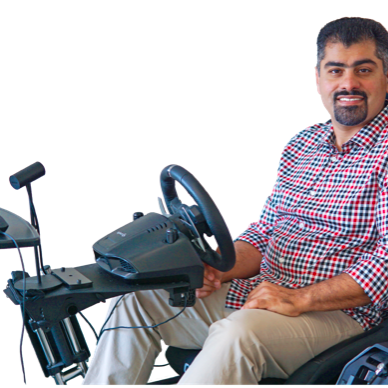

Research Terms
| Ends | Title |
| 09-2022 |
New Reputation-Based Mining Paradigm: Incentivizing Blockchain Miners to Avoid Dishonest Mining Strategies
New Reputation-Based Mining Paradigm: Incentivizing Blockchain Miners to Avoid Dishonest Mining Strategies
Department of Defense-Federal
|
| 05-2017 |
Towards Software Defined Networking Enabled Cyber Resilience
Towards Software Defined Networking Enabled Cyber Resilience
Florida Center for Cybersecurity (USF)-State
|
The key challenge for autonomous and semi-autonomous vehicles is their reliance on fixed speed limits and adjacent vehicle behavior, which fails to reflect real-time traffic conditions. Current systems like Adaptive Cruise Control (ACC) and Traffic-Aware Cruise Control (TACC) respond only to nearby vehicles, leading to abrupt braking and inefficient adjustments, increasing accident risks and fuel consumption. These solutions lack the broader situational awareness needed for optimal traffic management.
Researchers at Florida Atlantic University have developed an Adaptive Speed-Limit Measurement (ASM) system to overcome these limitations. Unlike traditional ACC and TACC, ASM uses real-time data from multiple vehicles to calculate a dynamic, traffic-aware speed limit. By leveraging machine learning algorithms, ASM adjusts speed based on traffic flow and road conditions, ensuring smoother driving, fewer sudden stops, and improved energy efficiency. Currently in the prototype phase, ASM shows promising results and is poised for further development and commercialization.
FAU seeks to advance this innovation into the marketplace through licensing or development partnerships.
Automation, artificial intelligence, and sensors are creating new manufacturing and distribution processes. Digitized robots perform tasks (or collaborate), and humans supervise manufacturing and quality. The COVID-19 pandemic has created a new manufacturing norm involving a remote workforce, leading to a shortage of staff where in-person human operations are still required. New technologies are needed to bridge this gap and help industries adapt to the new standard of manufacturing.
Researchers at Florida Atlantic University have developed a new cyber manufacturing platform comprising a virtual environment for production line workers. It enables employees to accomplish daily tasks in real-time through virtual meetings with robotic-arm (any robotic system) partners. Factory workers can meet with robotic-arm partners through video communication systems to perform tasks in the factory. In addition, the system adjusts its behavior (e.g., slowing) to respond to a worker's emotional state, such as trust, fatigue, and other parameters.
FAU is seeking partners to advance this technology into the marketplace through licensing or development partnerships.
Significant gains in the commercialization of automated vehicle technologies have occurred over the past decade, in which a large number of vehicles on the road today feature some level of automation. Automation can be adaptive cruise control, automatic emergency braking, lane keeping assist, lane change assist, and pedestrian detection, to name a few. These features and systems range from Level 0 systems, which provide warnings but do not directly affect vehicle control (e.g., blind spot detection and backup cameras), to Level 2 technologies, that take control of the accelerating, braking, and steering systems.
A researcher at FAU has developed a novel adaptive driving mode for autonomous vehicles that mimics the driver's driving style and behavior. With this adaptive mode, the vehicle can learn the driving styles and behaviors of its various drivers and imitate that behavior (within safe driving limits). This provides a more comfortable and natural-feeling driving experience. The learning function of the adaptive driving mode allows the driver to operate the vehicle in fully manual mode while the system observes the driver's tendencies and behaviors, such as preferred driving lane, speed, braking style, following distance, preferred routes, etc. Then the technology correlates those behaviors to driving conditions based on vehicle sensors, environmental factors, and other vehicle data.
In addition to adaptive driving mode, the researcher has also developed adaptive mood control, in which the vehicle can learn the driver's preferred driving style based on their emotional and physiological responses. The learning function of the adaptive mood control utilizes both intrusive (e.g. seat and steering wheel mounted skin response sensors) and non-intrusive (cameras, microphones) devices to monitor and detect changes in the driver's emotional and physiological response. This information can all be used to characterize the driver's mood. Changes to such measurements can indicate anxiety, fear, distrust, discomfort, or unease in response to various driving and environmental related factors.
FAU is seeking partners to advance this technology into the marketplace through licensing or development partnerships.
Motor vehicle injuries are a leading cause of severe injury and death. There is a need for safety systems that encourage drivers to operate vehicles in a safer manner around vehicles carrying children and other vulnerable populations, such as older adults and the disabled.
Researchers at Florida Atlantic University have developed an automated automotive safety system which both alerts adjacent drivers to the presence of vulnerable occupants in the vehicle while also alerting the driver to external unsafe driving conditions and driving behaviors. External sensors report on speed, distance and driving patterns of adjacent vehicles, as well as road and weather conditions. The system notifies the driver of changes in weather and road conditions, to changes in driving behavior of adjacent vehicles, and when an adjacent vehicle exceeds a speed threshold or the distance between the vehicle and the adjacent vehicle falls below a minimum separation distance. Digital panels located on the back and side windows of the vehicle display phrases such as "Baby on Board". If the system detects unsafe driving conditions, the display will change to red, then flashing red to warn adjacent drivers.
FAU is seeking partners to advance this technology into the marketplace through development partnerships.
Sun glare is a growing problem that impairs the vision systems of autonomous vehicles. It significantly reduces the visibility of objects and road markings, posing a risk to safe operation and potentially leading to accidents. Current solutions often involve expensive hardware replacements or upgrades, which are not always feasible. As autonomous vehicle adoption increases, ensuring their functionality under various environmental conditions, including intense sunlight, becomes imperative.
Researchers at FAU have developed the Sun Glare Avoidance System (SAS), a technology that addresses this critical issue in the operation of semi and fully autonomous vehicles. SAS leverages existing vehicle hardware and advanced algorithms to detect and mitigate the effects of sun glare, thereby enhancing overall vehicular safety and performance. The innovation lies in its dual-phase approach: determining the presence of sun glare using pre-stored data and real-time video analysis, and then applying countermeasures like adjusting camera positions, using polarizing filters, or software adjustments. These methods, enhanced by AI and machine learning, ensure the vision system remains functional. This solution is not only cost-effective but also improves the reliability of autonomous vehicles under challenging lighting conditions.
FAU seeks to advance this innovation into the marketplace through licensing or development partnerships.
Autonomous vehicles (AVs) are revolutionizing transportation by offering increased safety and efficiency. However, they face challenges in detecting and responding to road hazards. The unpredictable nature of road hazards can lead to accidents and inefficiencies in autonomous vehicle operations. Current systems often rely on isolated sensors and historical data, which can be insufficient for real-time hazard detection.
Researchers at FAU have developed a Road-Risk Awareness System (RAS) that enhances AV safety by providing real-time hazard warnings. This system leverages cloud computing, AI, and machine learning to analyze data from diverse sources, such as state and federal transportation departments, to predict potential hazards. It quantifies risk factors and provides timely warnings to AVs, significantly enhancing their ability to avoid accidents. This innovation leads to improved safety, reduced insurance costs, and increased operational efficiency for autonomous vehicles.
FAU seeks to advance this innovation into the marketplace through licensing or development partnerships.









